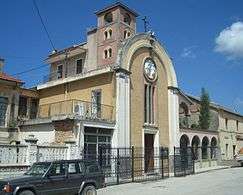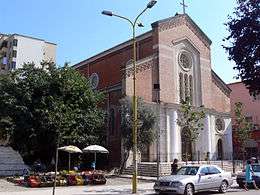Christianity in Albania
.jpg)
Christianity in Albania was established throughout the country in 325 AD. From 1100 AD, the Byzantine Empire carried out Church missions in the area. In relation to the increasing influence of Venice, the Franciscans started to settle down in the area in the 13th century. From the 15th century to the 19th century, under the rule of the Ottoman Empire, Christianity was replaced by Islam as the majority religion in Albania. A Pew Research Center demographic study from 2010 put the percentage of Muslims in Albania at 82.1%.[1] However, the Albanian government gives the percentages of religious affiliations with only 36% Muslim, 28% Eastern Orthodox, 21% Catholic and 15% atheist or nonreligious since the fall of Communism in 1991, yet the 2011 census did not get most of the population due to poor counting of the population and the inability to reach most citizens.[2] In the 2011 census the declared religious affiliation of the population was: 56.7% Muslims, 13.79% undeclared, 10.03% Catholics, 6.75% Orthodox believers, 5.49% other, 2.5% atheists, 2.09% Bektashis and 0.14% other Christians.[3] However, due to the low number of people actually reached during the collection of data for the census, especially in Catholic and Orthodox regions, this census can be viewed as not reliable.
A 2015 study estimated some 13,000 followers of Christ from a Muslim background, though it is not clear to which Christian churches these people had converted.[4]
Eastern Orthodoxy
According to the numbers given by the government in 2010 it was stated that Eastern Orthodoxy was practiced by about 20% of Albanians within Albania.[2] In the 2011 census the percentage of Orthodox believers was listed as 6.75% of the population.[3] However the census was poorly conducted and the population of Orthodox believers has recently increased to 28.4%. Albania is historically linked with both the Catholic Church and Eastern Orthodoxy as well as Islam. Albanians were among the first peoples of the region to receive missionaries and convert to Christianity. With the split of the Church in 1054, Orthodoxy become the religion for the Albanians inhabiting the areas under the Byzantine rule.
The first Orthodox liturgy in the Albanian language was held not in Albania, but in Pennsylvania and Massachusetts. Subsequently, when the Orthodox Church wasn't allowed an official existence in communist Albania, Albanian Orthodoxy survived in exile in Philadelphia with the church in Philadelphia being founded in 1913 and in Boston in 1965. Adherents of the Albanian Orthodox Church have been increasing in Albania since 1991 from a weak presence to 28.4% of the population in 2011.
Catholic Church

The Catholic Church in Albania is part of the worldwide Catholic Church, under the spiritual leadership of the Pope in Rome. According to the numbers given by the government in 2011 it was stated that around 10.03% of the religious population is Catholic,[2] however new government figures reveal the percentage of Catholics is 21.3 [3] There are five dioceses in the country, including two archdioceses plus an Apostolic Administration covering southern Albania.
Prior to the Ottoman invasion christianity was the religion of all the Albanians. The northern Albanians adhered to Catholicism, meanwhile the southern Abanians were followers of Orthodoxy.[5][6]
Protestantism
Protestants in Albania, stand at about 8,000,[7] whereas 189 different Protestant associations including the Albanian Evangelical Alliance (VUSH) exist in Albania.[8]

See also
Further reading
- Tönnes, Bernhard. "Albania." In The Encyclopedia of Christianity, edited by Erwin Fahlbusch and Geoffrey William Bromiley, 35-36. Vol. 1. Grand Rapids: Wm. B. Eerdmans, 1999. ISBN 0802824137
- Malaj, Edmond (2014). "Të dhëna mbi Krishterimin në trojet iliro-shqiptare para dhe pas Ediktit të Milanos (313). Me përqendrim tek martirologjia (Data on the Christianity in the Illyrian-Albanian Territories before and after the Edict of Milan 313. With a Concentration on the Martyrology.)". Studime Historike. Instituti i Historisë (Qendra e Studimeve Albanologjike). 3–4.
References
- ↑ Miller, Tracy, ed. (October 2009). "Mapping the Global Muslim Population: A Report on the Size and Distribution of the World's Muslim Population" (PDF). Pew Research Center. Archived from the original (PDF) on 8 November 2009. Retrieved 8 October 2009.
- 1 2 3 Albanian Government. "L'Albania oggi" (in Italian). Ministry of Foreign Affairs of Albania. Archived from the original on 10 May 2008. Retrieved 30 August 2010.
- 1 2 3 Albanian census 2011 Archived 14 November 2014 at the Wayback Machine.
- ↑ Miller, Duane; Johnstone, Patrick (2015). "Believers in Christ from a Muslim Background: A Global Census". IJRR. 11: 15. Retrieved 6 December 2015.
- ↑ Ramet, Sabrina P. (1989). Religion and Nationalism in Soviet and East European Politics. Duke University Press. p. 381. ISBN 0-8223-0891-6.
Prior to the Turkish conquest, the ghegs (the chief tribal group in northern Albania) had found in Roman Catholicism a means of resisting the Slavs, and though Albanian Orthodoxy remained important among the tosks (the chief tribal group in southern Albania),...
- ↑ Leften Stavros Stavrianos (January 2000). The Balkans Since 1453. C. Hurst & Co. Publishers. p. 498. ISBN 978-1-85065-551-0.
Religious differences also existed before the coming of the Turks. Originally, all Albanians had belonged to the Eastern Orthodox Church... Then the Ghegs in the North adopted in order to better resist the pressure of Orthodox Serbs.
- ↑ "First Protestant Church Dedicated". Christianity Today Library. Retrieved 2 February 2018.
- ↑ "International Religious Freedom Report 2007: Albania". State.gov. 15 September 2006. Retrieved 2010-05-13.
External links
- "Religious Freedom Page". 30 May 2013. Archived from the original on 30 May 2013. Retrieved 2 February 2018.
- "L'albania oggi". 10 May 2008. Archived from the original on 10 May 2008. Retrieved 2 February 2018.